Chords are the building blocks of music, setting the tone for melodies, and defining the harmonic foundation of your tracks.
They can evoke feelings of joy, sadness, tension, release, etc. with complex layer of sound to make your tracks stand out.
As a music producer, understanding different types of chords is key for creating dynamic and engaging tracks, regardless of style/genre.
That’s why, in today’s article, we’ll break down:
- What are chords ✓
- Major chords, minor chords, and other chords ✓
- The major scale (like C major scale) & minor scale ✓
- Extended chords ✓
- Diminished chords ✓
- Augmented chords ✓
- Suspended chords ✓
- Seventh chords (like Dominant seventh chords) ✓
- Chord progressions ✓
- Modulation and chord substitution ✓
- Chord inversions and voicings ✓
- Using chord charts ✓
- Chords on different instruments ✓
- Much more about different types of chords ✓
By the end, you’ll have a solid understanding of different chord types, so you can experiment and produce some seriously impressive chord progressions.
It will help you elevate your music and skills, plus connect with your listeners on a deeper, more memorable level.
Let’s dive in…
Table of Contents
What Are Chords? The Basics
Chords are a group of two or more notes played simultaneously that harmonize with each other. Understanding how chords work and how they’re constructed is essential for any music producer. It will open up endless possibilities for creativity in production and arrangement. Let’s start with the two chords that are the foundation of all other chord qualities/types: major and minor chords.
-
Major Chords
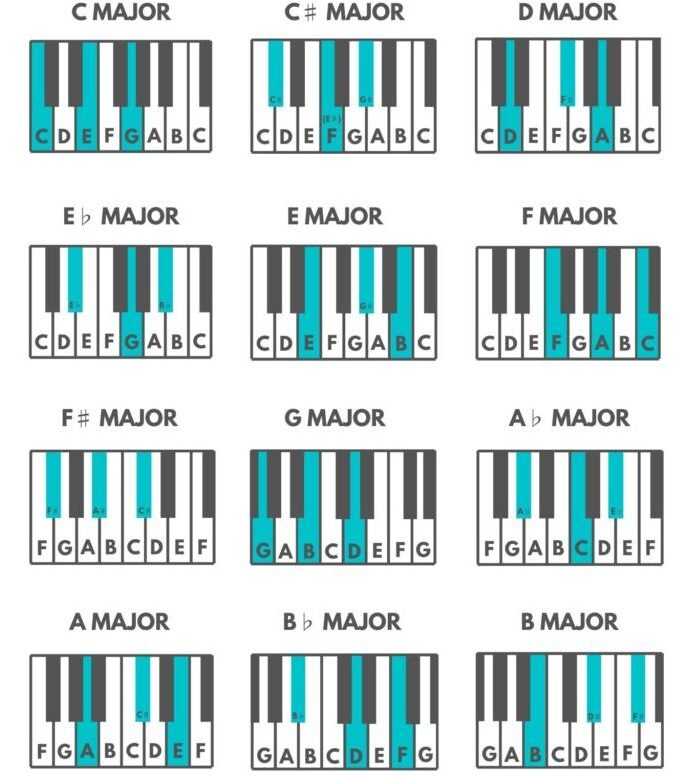
Major chords are characterized by their bright and uplifting sound, which makes them a staple in the most popular genres of music.
Major chords are built from a:
- Root note
- Major third
- Perfect fifth
This combination of chords offer a sense of happiness, joy, ecstasy, contentment, etc.
For example, a C major chord consists of the musical notes C, E, and G.
When it comes to music production and music theory, knowing how to construct and utilize major chords in your tracks can help set a positive tone.
NOTE: Experimenting with different voicings and inversions of major chords can also add variety to your music.
For instance, playing the E note (the third) in the bass for a C major chord can give your chord progression a fresh sound.
Additionally, layering sounds from different instruments playing the same major chord can create a rich, full-bodied harmonic backdrop for your tracks.
It will enhance the overall texture and depth of your music.
Understanding the role of major chords in chord progressions is just as important.
They often serve as the starting point or “home base” in a progression 一 providing a resolution point for other, more tension-filled chords.
For example, in a simple I-IV-V progression in the key of C, the chords C major, F major, and G major work together to create a satisfying and complete musical phrase, with the C major chord holding down the progression.
-
Minor Chords
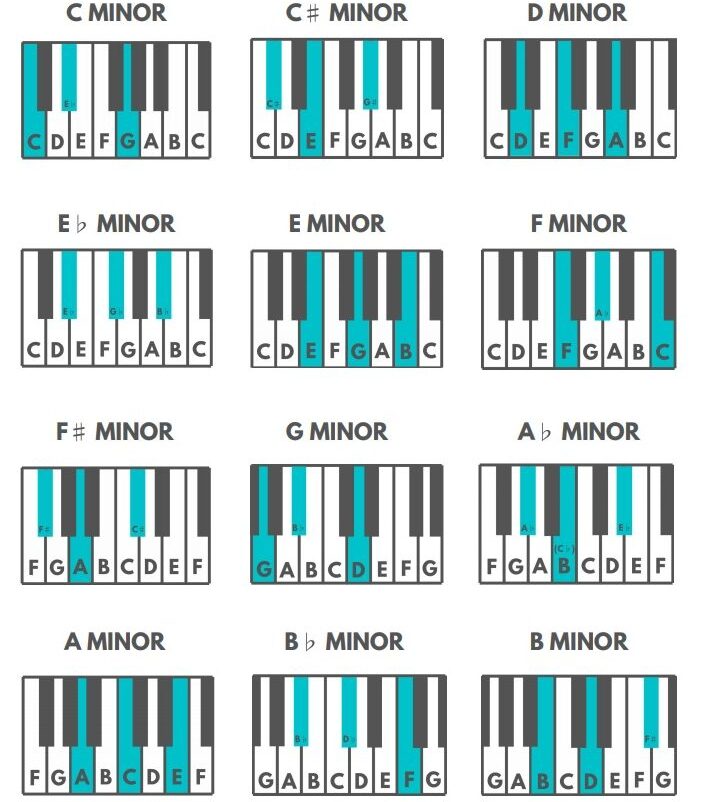
Minor chords bring the complete opposite vibe as major chords; sadness, depression, introspection, etc.
They consist of a:
- Root note
- Minor third
- Perfect fifth
An A minor chord, for example, is made up of the musical notes A, C, and E.
The minor third (C in this case) is what gives the chord its distinctive somber tone.
In music production and music theory, using minor chords effectively can add emotional depth to your tracks 一 conveying feelings of longing or other relatable sad emotions.
Incorporating minor chords into your chord progressions can create a dynamic, emotional track that will certainly get people in their feelings.
By moving from a minor chord to a major chord (or vice versa) you can create moments of beloved tension and release that keep your listeners engaged.
For instance, transitioning from an Am chord to an F major chord introduces a subtle shift in mood, from introspective to more open and hopeful.
This just shows the power of minor chords in shaping the emotional tone.
Just like major chords, exploring with different voicings and inversions of minor chords can further enhance their impact.
For example, playing an E minor chord in its first inversion (E-G-B) with the G note as the lowest tone can provide a slightly different emotional nuance.
It adds some extra complexity to your chord progressions.
Expanding on major and minor chords, let’s now discuss major and minor thirds.
-
Major Thirds
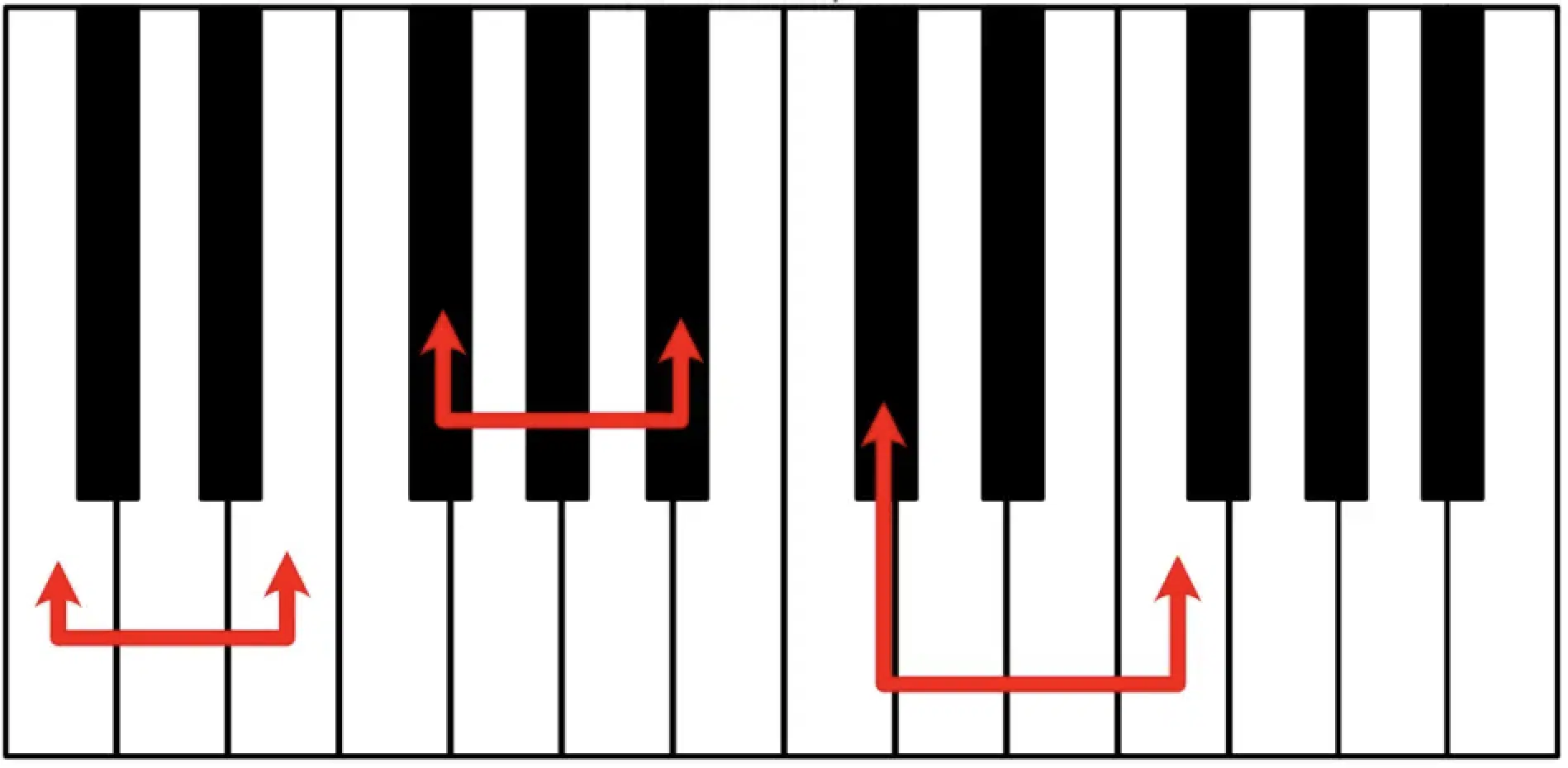
Major 3rds; 4 semitones
When we talk about the building chords, especially when you’re first exploring what are chords, major thirds play an important role.
A major third is an interval that spans four semitones (or half steps) making it a key ingredient in creating a major chord’s unmistakably bright and positive sound.
For instance, in a C major chord, the interval between the root note C and the E note is a major third.
This interval gives the C major chord (three notes: C-E-G) its characteristic uplifting quality that people are really drawn to.
Understanding how to identify and use major thirds can significantly affect the emotion/vibe you’re aiming to convey in your track.
When building chords in a DAW, shifting a note up or down to create a major third interval can change a chord’s quality from minor to major.
It alters the track’s overall feel and will keep people interested.
For example, transforming an A minor chord (A-C-E) into an A major chord (A-C#-E) by raising the C to a C#, introduces a major third into the chord.
Major thirds are not just fundamental in chord construction 一 they also serve as a basis for melody composition.
A melody that moves in major thirds can sound hopeful and joyous.
As music producers, experimenting with major thirds over different bass notes can uncover a variety of harmonic possibilities.
This makes it a powerful tool in your music theory arsenal. Now that you have a handle on major and minor triads, let’s move on to thirds.
-
Minor Thirds
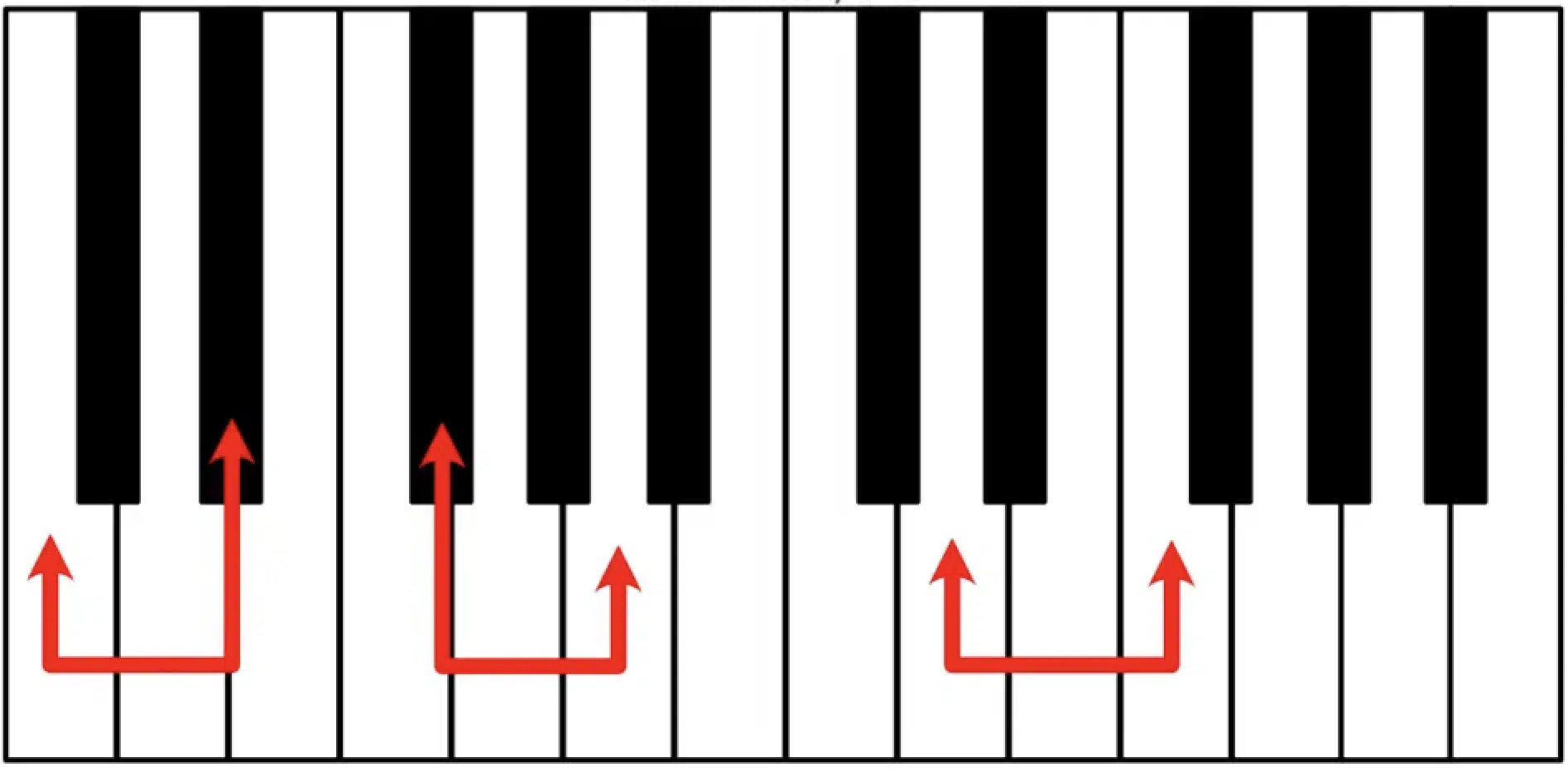
Minor 3rds; 3 semitones
In contrast to the bright and uplifting feel of major thirds, minor thirds (being part of minor scales) introduce a sense of sadness.
It’s key to answering the question “what are chords” and what emotional impacts they might bring to the table.
A minor third is an interval consisting of three semitones.
Take the A minor chord (A-C-E), for example… The interval between A and C is a minor third, giving the chord its distinctively somber tone.
Minor thirds are essential for constructing minor chords, but their influence extends beyond chord formation.
In EDM production, playing with minor thirds can add depth and complexity to a seemingly simple, bassic progression 一 completely enriching your track’s texture.
NOTE: Experiment with minor thirds in your basslines or lead synths to create a more evocative soundscape.
For instance, layering a melody with minor thirds over a major chord progression can create a tension-filled chord quality.
It brings the listener on a more complex, immersive journey.
Now that you understand the major scale/minor scale and minor/minor thirds, let’s move on to major and minor triads.
-
Major Triads
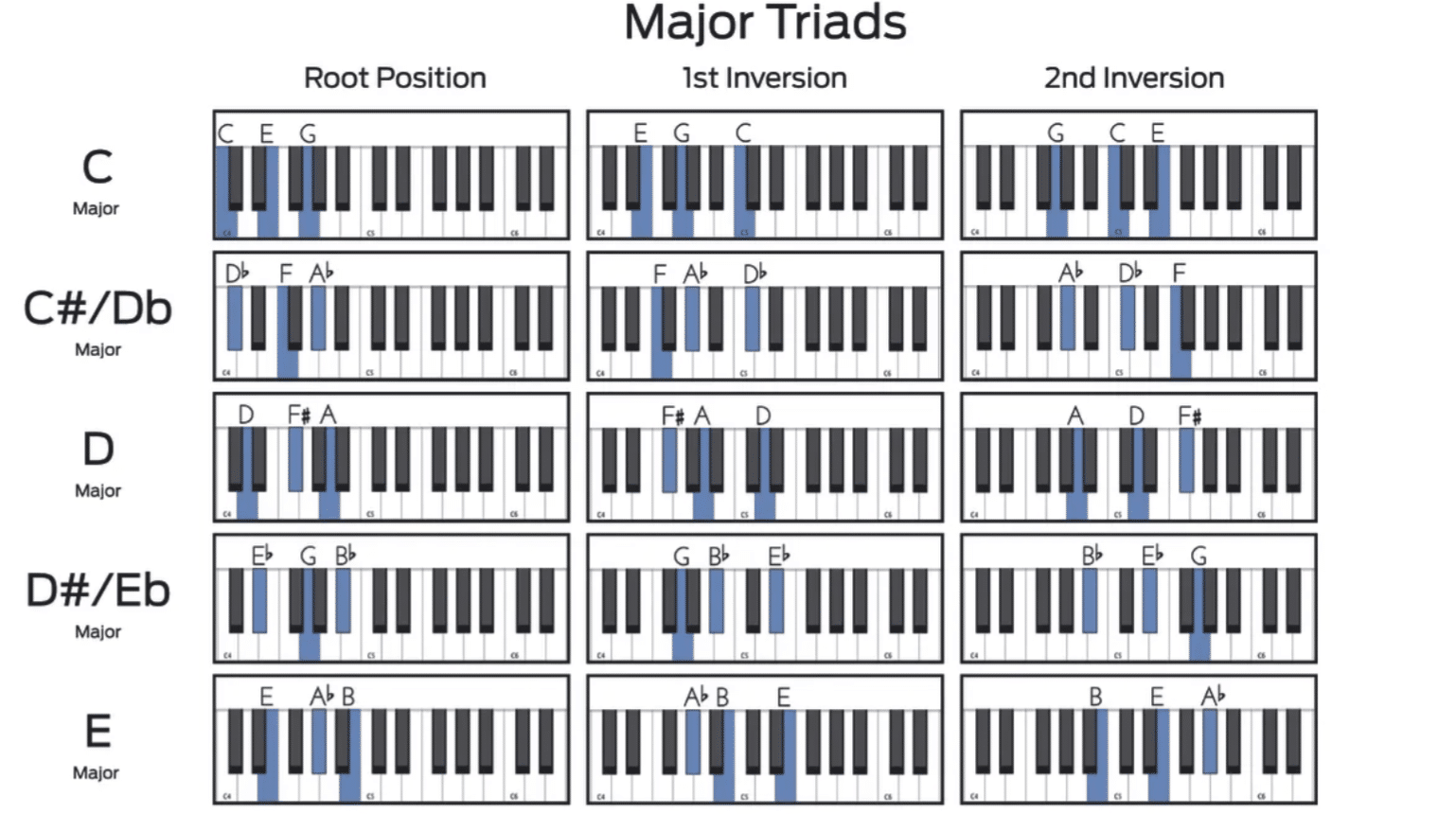
Major triads are perhaps the most fundamental chord type in Western music, non-negotiable for anyone looking to truly understand “what are chords” in depth.
A major triad consists of three notes:
- The root note
- A major third
- A perfect fifth from the root note
This can be seen in the C major triad (C-E-G; three note chords) 一 where C is the root, E is the major third, and G is the perfect fifth.
Mastering major triads is key to creating fluid and catchy tracks.
Building chords like these is how you’re going to match the standards of other chords in popular music.
It offers a straightforward yet powerful way to convey happiness and stability.
In your DAW, laying down a major triad can serve as the starting point for a chord progression, setting a positive tone for the entire piece.
Pro Tip

An interesting way to experiment with major triads, and other types of chords, is through inversion.
For example, playing the E note (the third) in the bass instead of the C note can give the C major triad a different flavor.
This will make your chord progressions more diverse and interesting.
Using basic triads like these can be particularly effective in genres like pop and electronic music, where the chord qualities and energy levels are key.
Remember, playing around with major and minor triads are a super innovative way to practice and enhance your skills.
-
Minor Triads
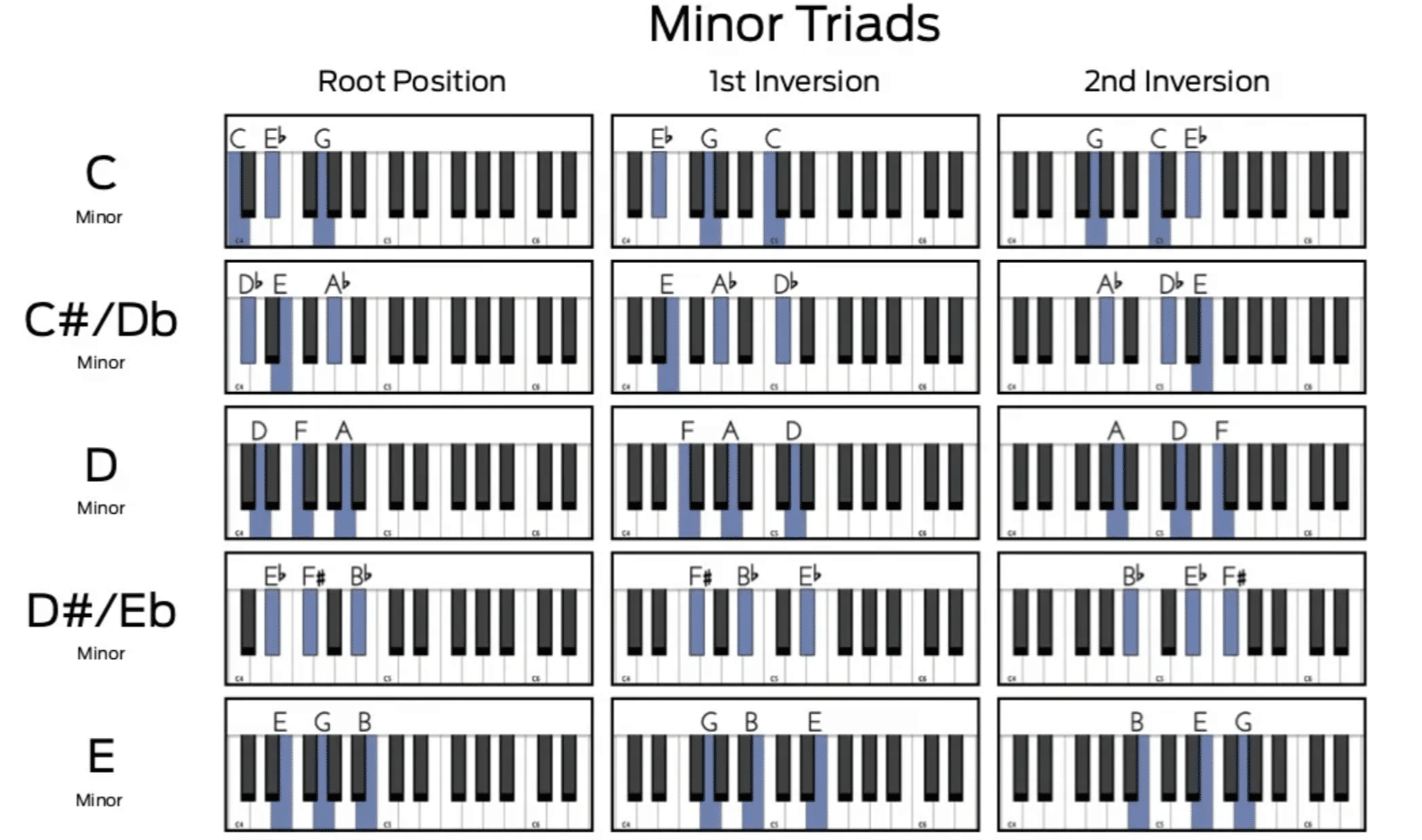
Minor triads, characterized by their reflective and sometimes somber tone, are as vital to popular music as their major counterparts.
A minor triad is made up of a root note, a minor third, and a perfect fifth.
The A minor triad (A-C-E) is a classic example, where the interval between A and C forms a minor third, imparting the chord with its distinctive emotional depth.
Minor triads are indispensable for crafting sections of a track that require a more introspective or melancholic feel.
They’re the backbone of many a minor key piece, providing a contrast to the brighter sections built on major triads.
Incorporating minor triads into your productions can add a layer of emotional complexity, engaging your listeners on a deeper level.
Pro Tip
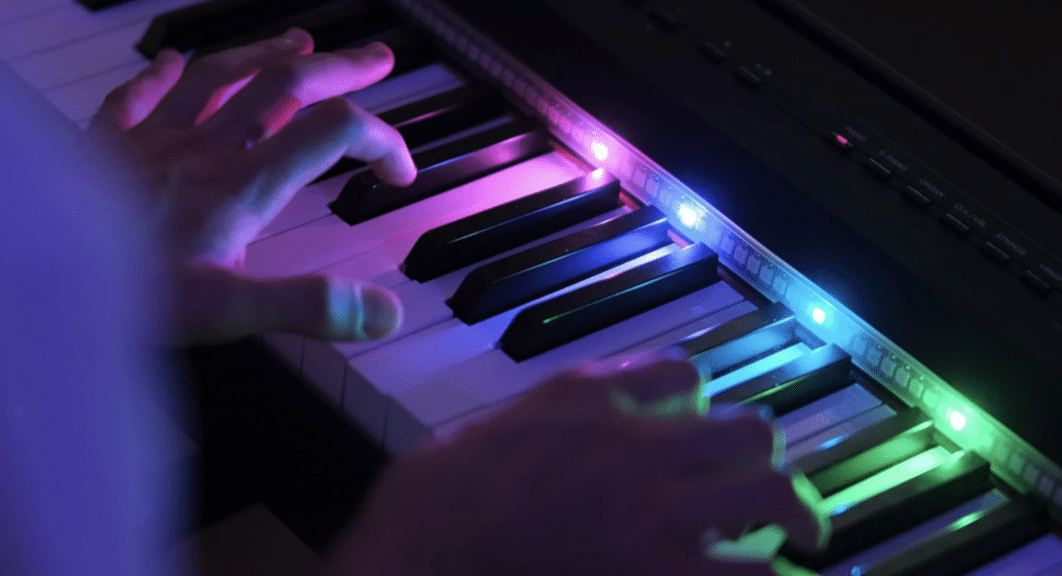
Experimenting with minor triad inversions is a great way to shake up your chord progressions and blow your competition away.
For example, placing the C note (the third) in the bass for an A minor chord can alter the chord’s perceived mood, even while retaining its minor quality.
This approach can be especially effective in creating unique soundscapes in genres such as ambient and downtempo.
Remember, when it comes to different chords (and music theory) understanding the basic form is key.
It will help you advance to, and master more complex types of chords.
Different Types of Chords: Breaking it Down
When you’re exploring the question “what are chords” it’s just as important to utilize the more advanced chords as using basic chords. So, let’s dive in.
-
Extended Chords
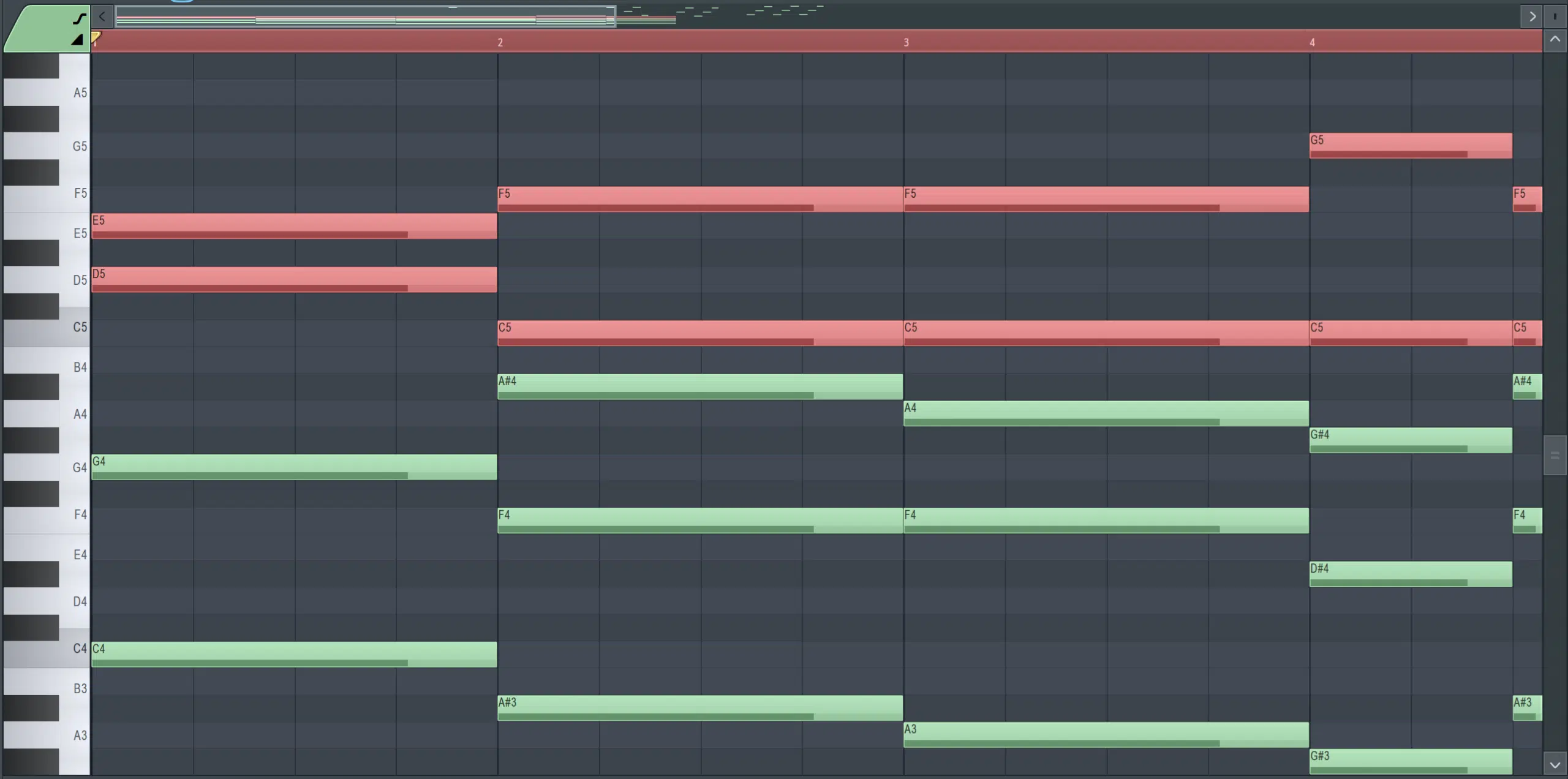
Extended chords are like the spices of music: just like the right amount of seasoning can transform a dish, extended chords can add depth and complexity to your song.
It makes it more emotionally powerful and interesting.
Extended chords extend beyond the basic triad and seventh chords by incorporating additional tones from the scale, specifically the:
- Ninth intervals
- Eleventh intervals
- Thirteenth intervals
For instance, in the world of music production and music theory, a C9 chord can offer a richer, more textured sound than a simple C major triad (three notes: C-E-G).
Side note, a C9 chord adds the note D (the ninth interval) to a C7 chord (C-E-G-Bb-D).
This extended chord doesn’t just add three or more notes 一 it adds layers of meaning and emotion to your music and gives you a super lavish backdrop.
When you include a C9 in your track, you’re telling your listeners that you’re skilled when it comes to harmony and can bring a unique flavor to the table.
-
Diminished Chords
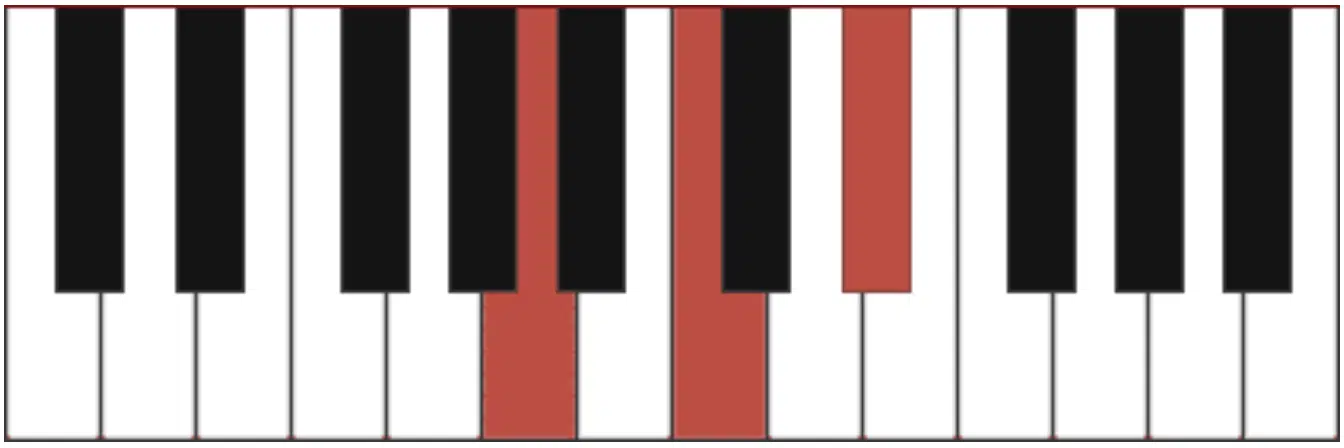
Diminished chords have a distinct, slightly unsettled sound compared to some other types of chords because they’re made up of a unique combination of notes.
Specifically, these different chords are built by:
- Taking a root note
- Then, adding a note that’s three semitones above (a minor third)
- Topping it off with another note that’s three semitones above the second note (making it a diminished fifth from the root).
For example, a B diminished chord includes the notes B, D, and F.
This setup gives the chord its tense and mysterious sound, which is perfect for creating suspense or an uneasy feeling in your music (like dark hip-hop vibes).
Using diminished chords in your tracks, especially in genres like hip-hop, trap, pop, and EDM, can add a layer of depth that grabs the listener’s attention and doesn’t let go.
They work great in transitions or just before a drop 一 creating a build-up that feels like something huge and explosive is about to happen.
NOTE: If you’re working on a track and you want to introduce a moment of tension or an unexpected twist, try slipping in a diminished chord like B-D-F and feel the vibe change instantly.
This will keep your listeners hooked and make your beats more dynamic, emotionally charged, and downright addicting.
-
Bonus: Diminished Triads
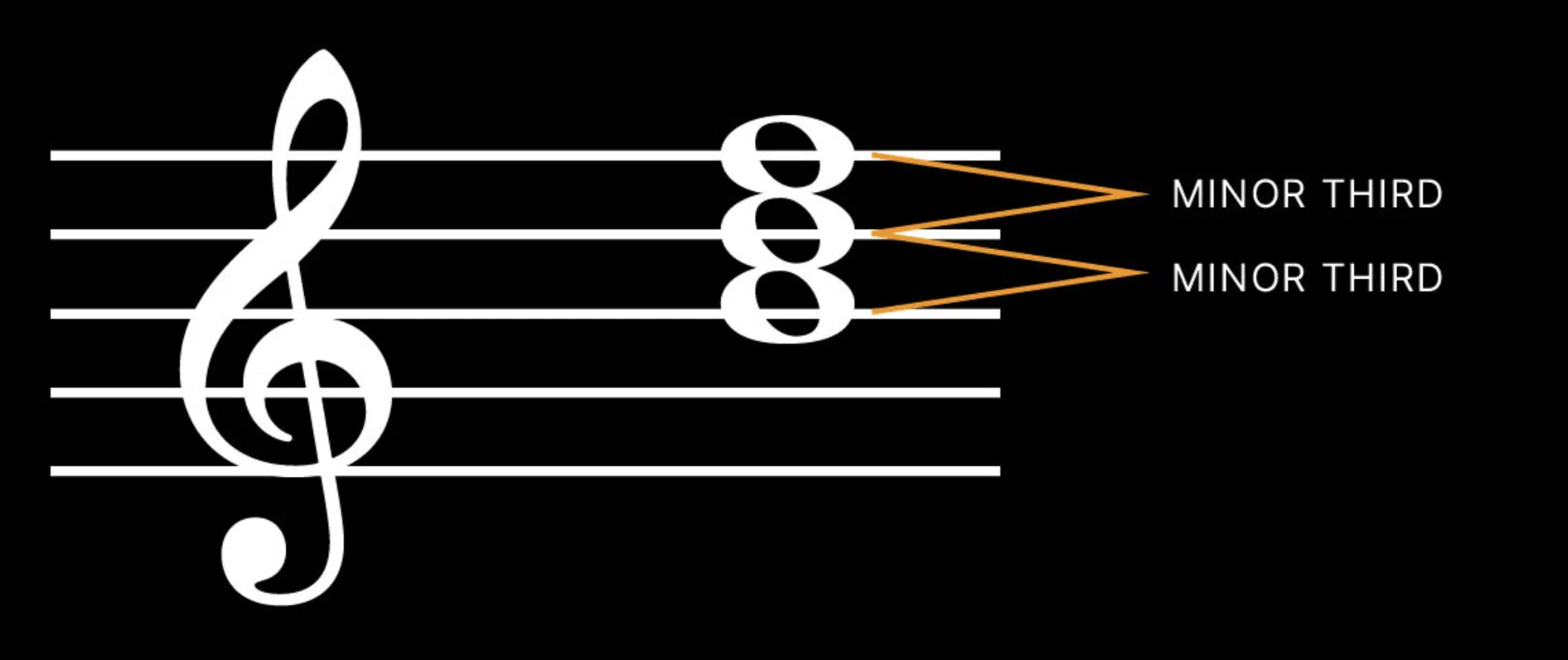
Understanding and incorporating diminished triads can be a game-changer.
These chords consist of two minor thirds stacked on top of each other, such as a B diminished triad (B-D-F).
They’re excellent for creating a sense of dissonance and tension, as it:
- Can serve as a compelling lead-in to more stable chords
- Creates a dramatic shift in your music’s mood
- Adds some much-needed dynamics
Make sure to experiment with diminished triads in your transitional sections or as part of a wicked buildup.
For example, layering a B diminished triad before dropping into a vibrant E minor chord (E-G-B) in an EDM track can create a breathtaking moment of tension and release.
It won’t only captivate your audience, but could help you make a name for yourself in the music industry (remember, innovative music always stands out).
By mastering diminished triads, you can add some edge to your chord progressions that sets your popular music apart.
-
Augmented Chords
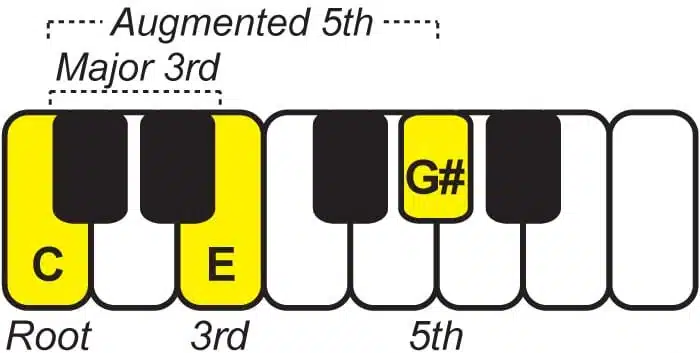
Augmented chords are like the plot twists in your favorite movie; they surprise you and keep things interesting.
Augmented chords are formed by:
- A root note
- Then, you add a major third
- Finally, an augmented fifth from the root
Meaning, if you take a C augmented chord as an example, you’re looking at the notes C, E, and G#.
The musical key here is the G#.
It’s one semitone higher than the G you’d find in a regular C major chord 一 giving the augmented chord its uplifting, suspenseful sound.
Augmented chords can help you make certain moments of your track stand out.
They have a way of capturing the listener’s ear because they sound so unique, yet authentic and genuine.
Let’s say you’re building up to a drop in an EDM track and are playing around with different chords…
Placing a C augmented chord right before the drop can make that moment feel even more exciting and unexpected.
It’s all about using these chords to add color and emotion to your music, which creates a listening experience that keeps your audience hooked from start to finish.
-
Suspended Chords
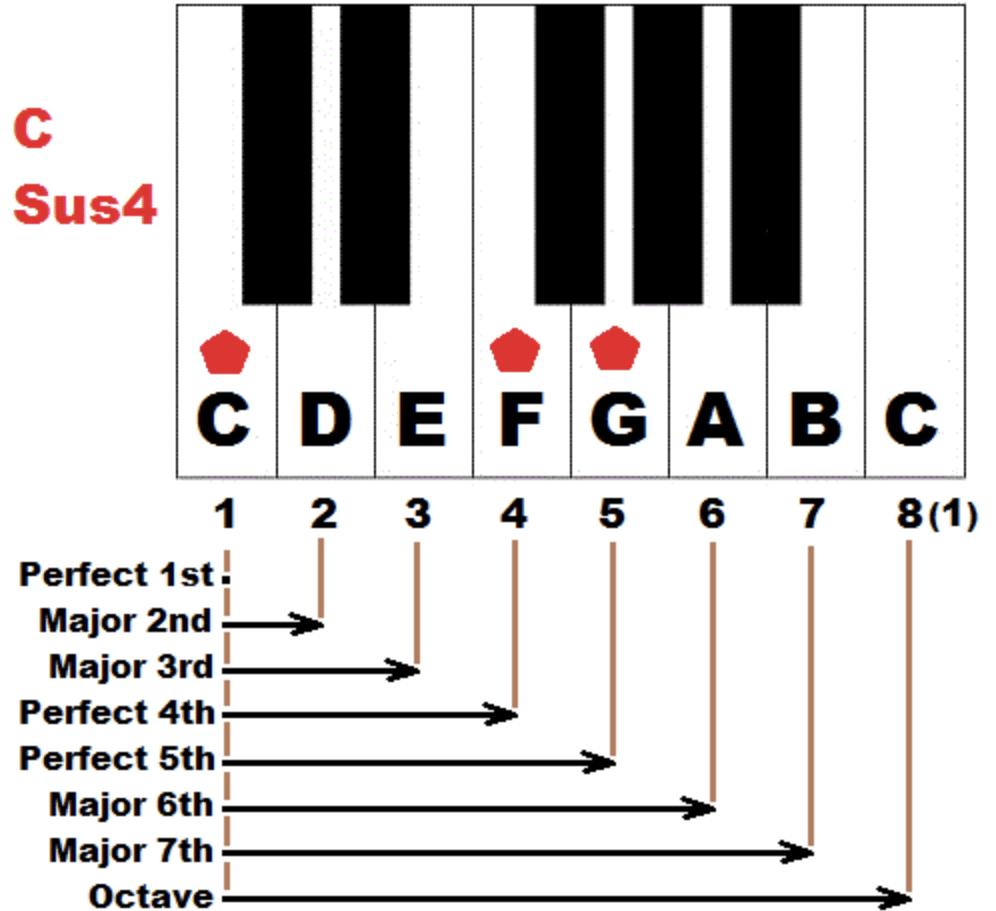
Suspended chords stand out from other types of chords with their unique ability to create a sense of anticipation and resolution.
Unlike major and minor chords, which establish a clear and definite mood through their third intervals, a suspended chord temporarily omits the third.
It replaces it with either a second (sus2) or a fourth (sus4).
This substitution gives you a unique sound, neither major or minor, which has this unresolved quality that can perfectly lead into a more definitive chord.
So, when you want to produce an enticing, great chord progression, suspended chords can certainly help, like all of the other different chords we’re talking about today.
The allure of suspended chords in popular music lies in their versatility and the dissonant sound they can introduce.
It gives a super refreshing break from the predictability of traditional major and minor chords.
Suspended chords are often used to build chords that bridge passages between verses and choruses or to introduce subtle variations within a chord progression.
This adds depth and interest needed to top peoples playlists (and the charts).
Incorporating a suspended chord can elevate a chord progression 一 making it more complex, intriguing, and stand out.
Whether used here and there for dramatic effect or as a recurring theme, suspended chords can seriously boost the harmonics of your track.
-
Seventh Chords
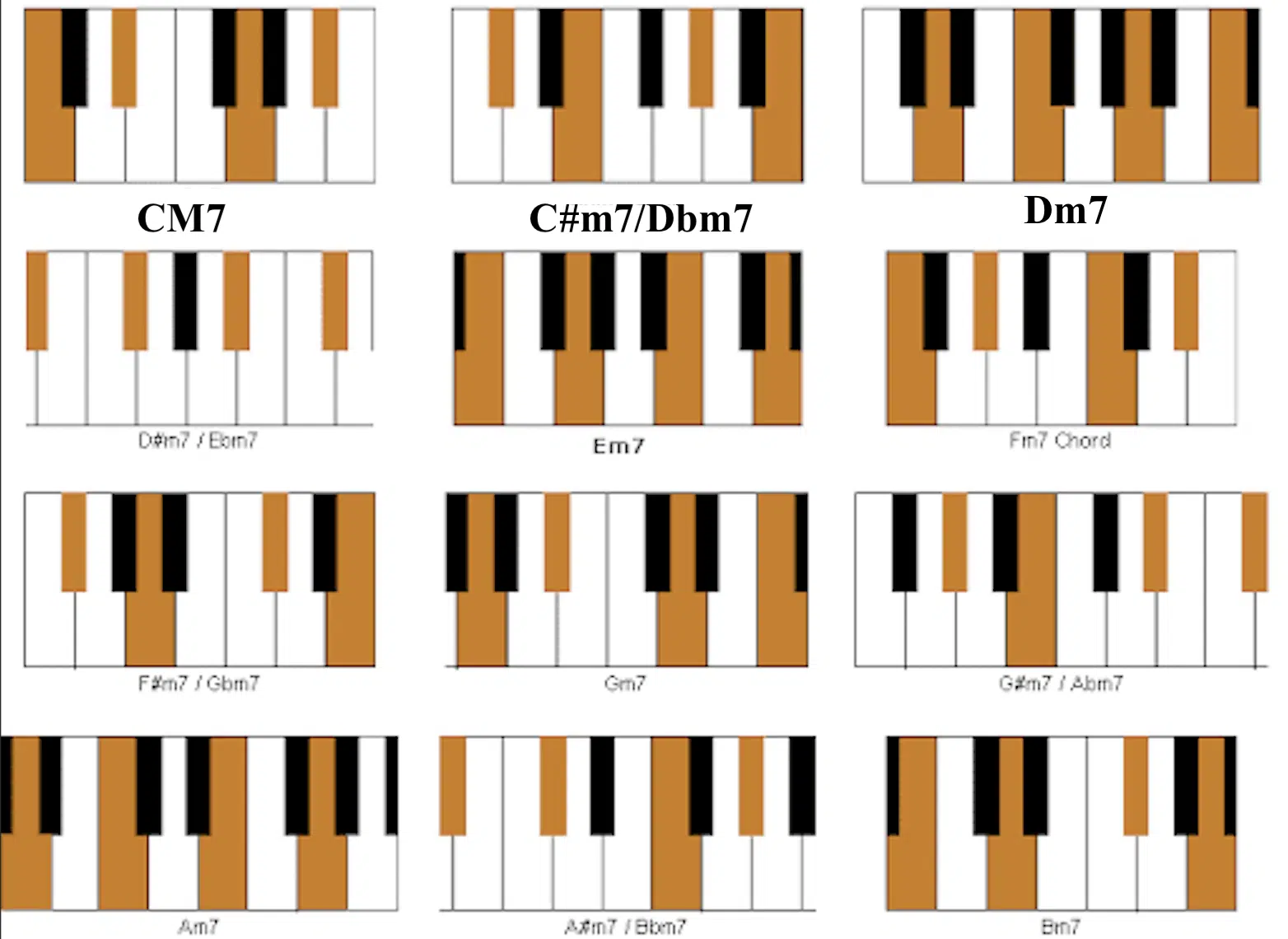
Seventh chords bring a spectrum of emotional depth to music, distinguishing themselves by the addition of a seventh interval atop the traditional triad.
They can be (broadly) categorized into major seventh and minor seventh chords, each offering its own flavor.
A C major seventh chord (Cmaj7) consists of C-E-G-B, which shines with a warm, almost dreamlike quality.
This is thanks to the B note that lies a major seventh above the root.
NOTE: The C major seventh chord’s sound is perfect for creating a soothing, reflective atmosphere in your tracks 一 think Post Malone.
On the other hand, a C minor seventh chord (Cm7) introduces a cooler, more laid back vibe.
It is made up of:
- C (first note)
- Eb (second note)
- G (third note)
- Bb (fourth notes)
The flat third (Eb) and the flat seventh (Bb) combine to give the Cm7 a smooth, mellow sound that’s ideal for adding a touch of soul to your music.
Whether you’re creating a laid-back hip-hop beat or a club-shaking EDM build-up, the Cm7 can be your go-to chord for bringing extra depth and feeling.
Diving deeper into seventh chords, let’s talking about chord progressions…
Let’s say you have a sequence moving from a Cmaj7 to an Am7 (A, C, E, G) and then to a Dm7 (D, F, A, C).
This great chord progression smoothly transitions from a bright and airy feeling to a more grounded and contemplative mood, showing how versatile seventh chords are.
By incorporating both major seventh chords and minor seventh chords into your music, you can create rich, dynamic tracks that really stick with your listeners.
-
Altered Chords

Altered chords are the wild cards of chord progressions when compared to some of the other different chords.
By altering one or more notes in a chord (usually the fifth or the ninth), you can create a chord that sounds unexpected and complex.
This can be something like a C7#9 chord, where the G note in a C7 chord (C-E-G-Bb) is left as is, but the D note is sharpened to D#.
It adds a layer of sophistication and a slightly dissonant edge that other types of chords, like a chromatic chord can’t really achieve.
Side note, if you’d like to learn everything about chromatic chords, we’ve got you covered.
Altered chords can add a unique flavor to your tracks 一 making them shine.
They’re particularly useful in creating memorable hooks or in certain sections of a song that need a bit of tension and complexity.
While an altered chord might seem daunting at first, experimenting with altered chords in your DAW can open up new possibilities for your music.
It offers fresh sounds that can captivate your audience.
-
Creating Show-Stopping Chord Progressions

A great chord progression will guide the emotional flow of your track and help you connect with listeners.
To create a progression (two or more chords) that stands out, start with understanding the relationship between chords.
For instance, moving from a C major chord (C-E-G) to an A minor chord (A-C-E) can offer a smooth, yet emotionally compelling transition due to their shared notes.
Experimenting with unexpected chord changes can also captivate your audience.
Take, for example, a progression like:
- C major
- G major (G-B-D)
- B diminished (B-D-F)
- E minor (E-G-B)
It utilizes a mix of harmonious and tense intervals that can make your track more innovative and show-stopping.
This chord progression combines the reassuring sound of major chords with the tense diminished chord leading smoothly into the melancholic E minor.
It will exude this rich narrative that gives your track some extra life.
Using extended chords, such as seventh or ninth chords, can add complexity and depth.
A progression from Cmaj7 (C-E-G-B) to Dm9 (D-F-A-C-E) introduces layers of beautiful texture, making the music more sophisticated and engaging.
When you build chords like this, it doesn’t just enhance the harmonic content but gives you a chance to discover new melodic possibilities.
-
Advanced Techniques: Modulation and Chord Substitution
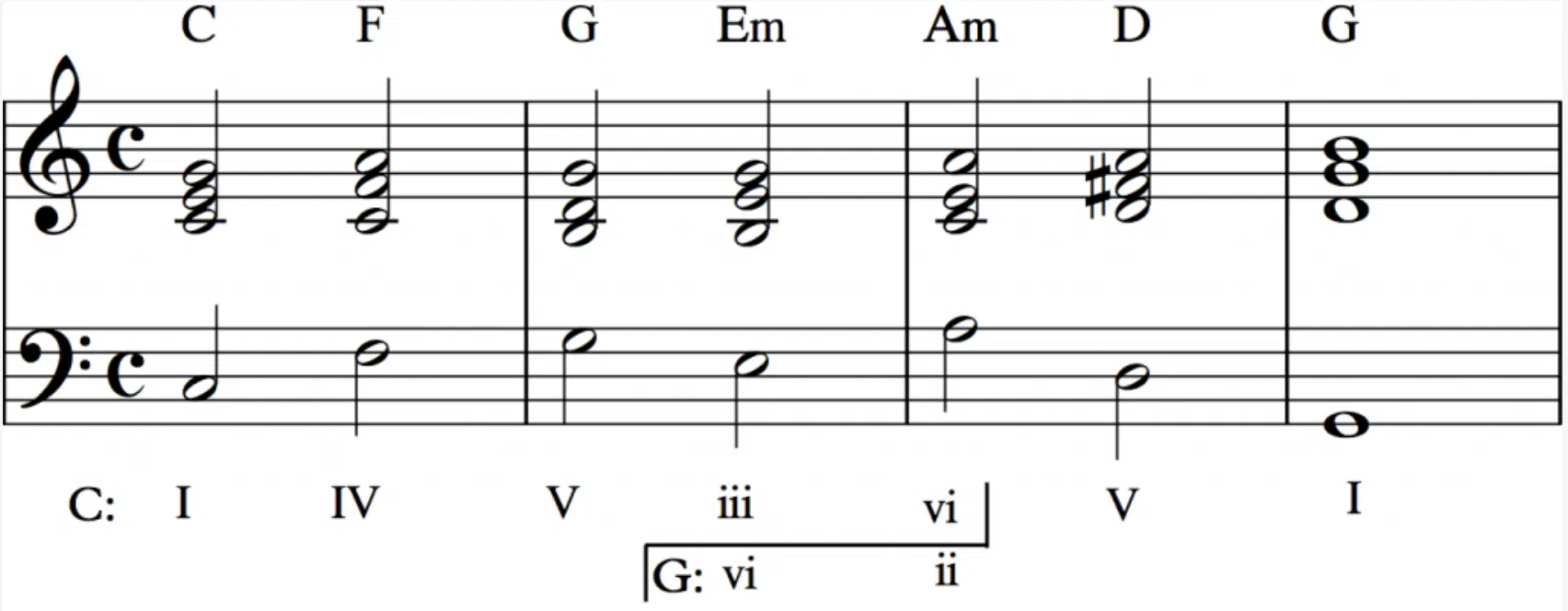
Modulation (the act of changing from one musical key to another within a piece) can dramatically shift the mood and grab your listener’s attention.
For example, transitioning your track from C major to G major (up a perfect fifth) can inject energy and brightness.
This can be done smoothly by using a pivot chord that belongs to both keys, such as D7 (D-F#-A-C), which prepares the ear for the key change.
It keeps the flow natural, engaging, and overall pleasant.
Chord substitution is another powerful tool…
It involves replacing a chord in your progression with another that shares some harmonic functions 一 adding surprise and variety to your music.
A common substitution is replacing the IV chord with a ii chord.
NOTE: In the musical key of C major, instead of moving from F major (F-A-C) to G major, try using Dm7 (D-F-A-C) before hitting the G major chord.
This substitution maintains the harmonic flow while introducing a slightly different color, making your progression more captivating.
-
Chord Inversions & Voicings
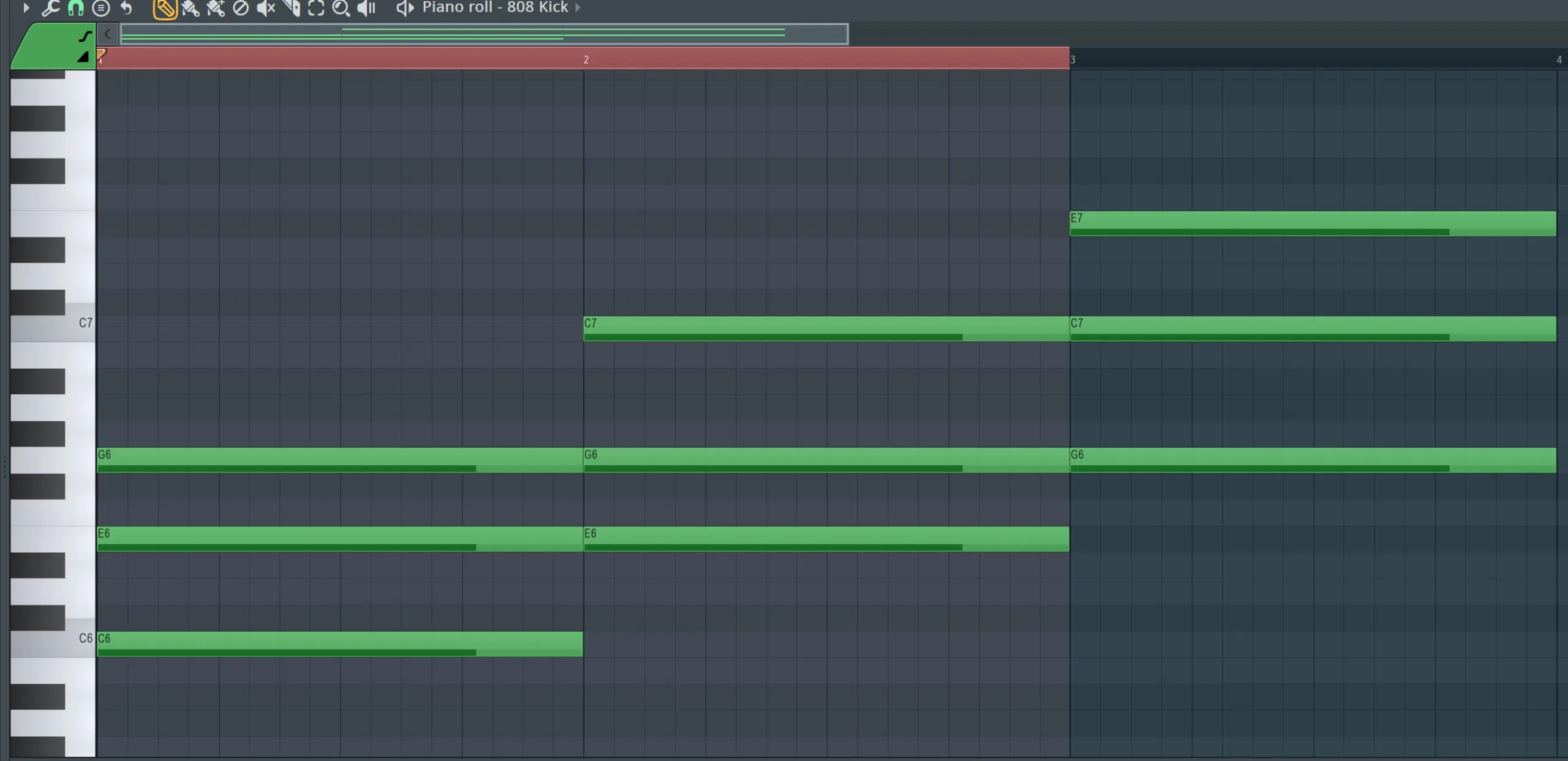
Chord inversions and chord voicings are essential techniques for bringing your chord progressions to life and helping them sound more professional.
A chord inversion simply means playing the chord with a different note in the bass than the root.
For instance, a C major chord played in its first inversion would have E in the bass (E-G-C), giving the chord a different texture and feel.
Experimenting with voicings, or the order and spacing of the musical notes in a chord, can also dramatically change its impact.
For example, spreading out the notes of a G major chord (G-B-D) across octaves can make the chord sound bigger and more expansive.
This is ideal for a powerful moment in your track.
Using inversions can help smooth out transitions between chords in a progression.
Moving from C major in root position (C-E-G) to its first inversion before transitioning to an F major chord (F-A-C) can make the progression flow more smoothly.
This songwriting technique reduces the physical distance your fingers or MIDI notes need to travel, which will create a more cohesive sound.
-
Pro Tip: Using Chord Charts
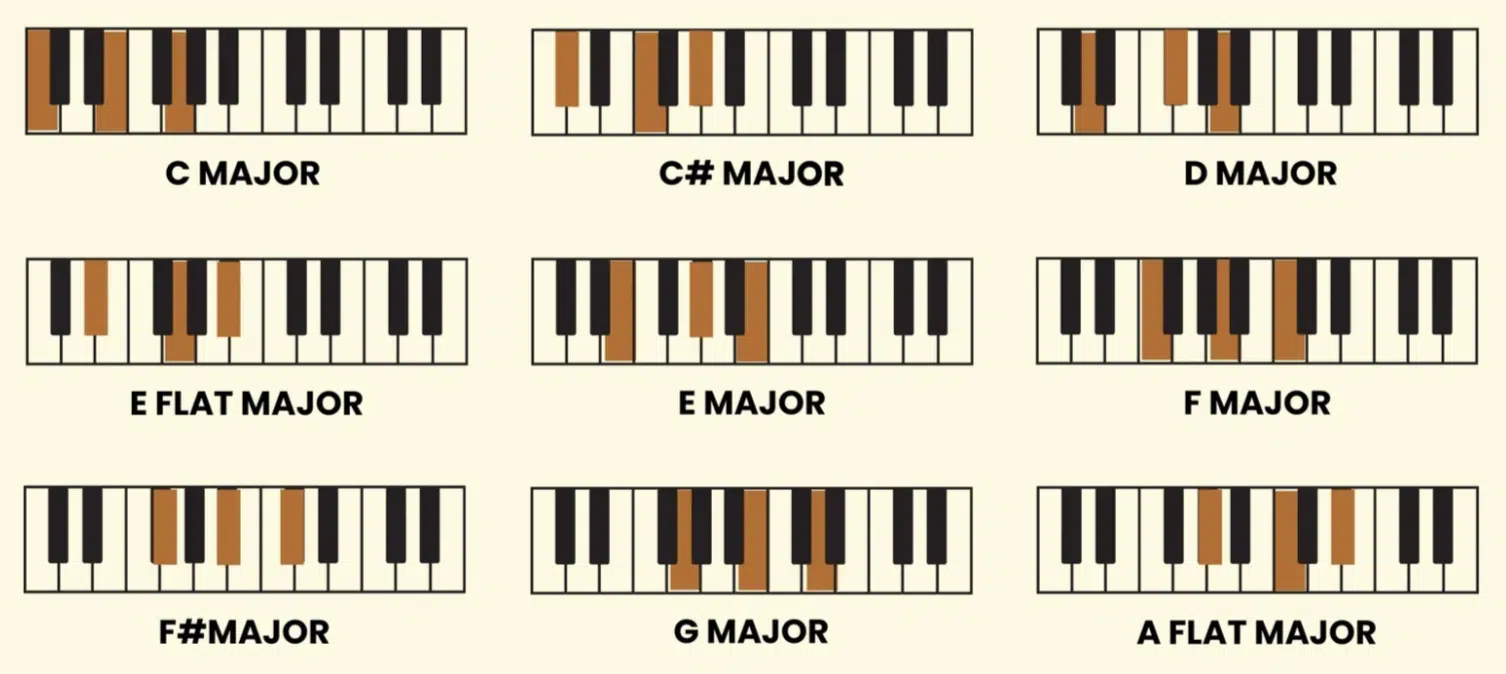
Chord charts are invaluable tools for music producers; they offer a visual representation of chord structures and their positions on various instruments.
Chord charts can be particularly helpful when you’re experimenting with new chord progressions or learning the intricacies of chord voicings/inversions.
For instance, a chord chart for a Cmaj7 might show you several different ways to play this chord on a guitar.
From the basic open position to more complex voicings higher up the neck.
What are Chords? Final Thoughts
Chords are the key to unlocking emotional and harmonic richness in your music.
They help set the stage for melodies that stop people in their tracks and leave a lasting impression.
Plus, by getting creative and experimenting with the diverse types of chords we broke down today, you can easily transform your tracks from basic to mind-blowing.
This way, you’ll never have to ask yourself, “what are chords?” again.
To fast-track your chord journey even further, there is no better resource than these Free Essential Famous MIDI Chord Progressions.
Seriously, it’s a complete game-changer and can help get your music millions of plays.
It contains 24 exact progressions from some of the catchiest, most popular songs around 一 replicating artists like Post Malone, Ariana Grande, Disclosure, The Weeknd, and so many more.
This way, you’ll be in the express lane to chord progression mastery and chart-topping succes.
If the question is “what are chords?” than the answer lies in this highly-renowed pack.
Whether you’re looking to elevate a song you’re already working on or want a (proven) hit foundation for a new song right off the bat, the choice is yours.
Plus, everything is 100% royalty-free, done-for-you, and compatible with all your favorite sounds, so the sky is not even the limit.
So, let the chords you choose and the progressions you create tell a unique story so your music can leave an unforgettable mark on the industry.
Until next time…







Leave a Reply
You must belogged in to post a comment.